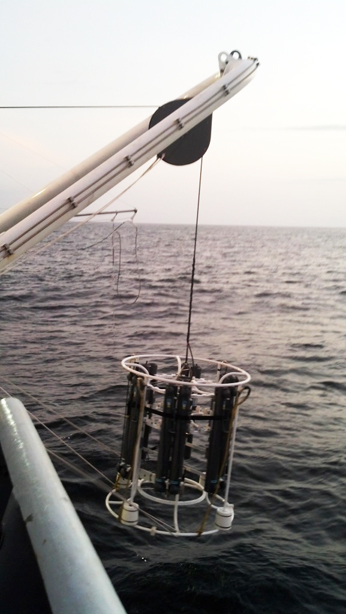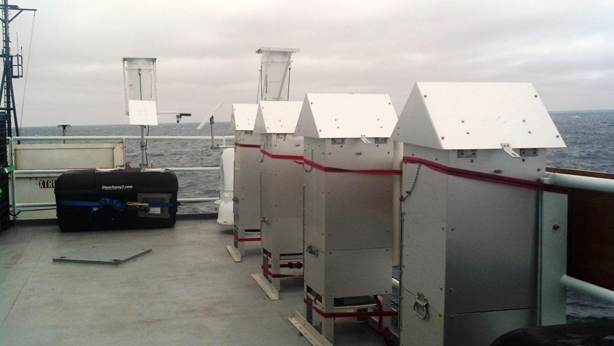UGA Skidaway Institute professor Cliff Buck is on a lengthy research cruise from Peru to Tahiti. Here is the second entry to is log of his experience.
Ahoy There!
Current Position: S 12.0449 W 77.3761
After 68 hours on location, we are finally leaving our first hydrographic station. A hydrographic station is a location that is chosen for intensive study. We will occupy 35 such stations over the course of the next two months and will use the data we collect at each to learn about the distributions of trace elements and isotopes (TEIs) in this region of the Pacific. We also measure basic parameters like temperature, conductivity/salinity, pressure, density, fluorescence and dissolved oxygen as these measurements can tell us about the movement of water masses within the ocean’s interior and help us interpret our chemical information.
We collect seawater and deploy sensors using plastic bottles mounted on a titanium frame called a rosette. The rosette is suspended from a sheathed Kevlar line which contains conducting wires that allow the transmission of signals between the surface and the rosette. In this way, we can monitor the depth of the bottles and can send them commands to close at specific depths. On this cruise, we are deploying a rosette able to hold 24 12-liter bottles, for a total of 288 liters of water on each cast

The GEOTRACES rosette being lowered over the side of the ship. The gray sampling bottles can be seen mounted on the titanium frame.
The entire package weighs approximately 1,600 pounds including the weight of the rosette, bottles, and sensors. The bottles are specially made of Teflon-lined plastic and contain no metal whatsoever to reduce the possibility that the sampling system will contaminate the seawater inside. The bottles can be detached from the rosette and carried into a clean sampling laboratory on board to reduce the possibility of contaminating the water inside. Once inside the lab, the water is filtered and stored in specially prepared plastic containers and bottles for either analysis on the ship or back on shore.
In addition to the rosette sampling system which brings seawater to the surface, a group of scientists from the Woods Hole Oceanographic Institution is deploying pumps that are able to operate to a depth of 5500 meters. These pumps are battery powered and are suspended from a wire lowered over the side. Their purpose is to filter 1200-1500 liters of seawater and to collect the microscopic particles which are present everywhere in the ocean. These particles have isotopic signatures that provide clues as to the circulation of the oceans and the rates at which particles sink from the surface ocean to the bottom. In the case of our first station, the bottom was 5500 meters (that’s 18,000 feet) beneath the ship’s keel.
My work, along with collaborators Dr. William Landing from Florida State University and Dr. Ana Aguilar-Islas of the University of Alaska – Fairbanks, is targeted on the input of TEIs to the surface of the ocean by atmospheric deposition. The atmosphere is full of small particles called aerosols which can include emissions from industrial processes as well as dust blown off of the continents. These particles can settle on the ocean’s surface by dry deposition or become incorporated into rain droplets and be scavenged from the atmosphere in wet deposition. We have installed four aerosol samplers on the highest deck of the ship which run vacuum motors pulling air through filters.

The four aerosol samplers can be seen in the foreground. The sampling filters are protected from sea spray and rain by the roof-like shrouds that give the samplers the appearance of birdhouses. The rain samplers are mounted in the background.
The aerosol particles are impacted onto these filters giving us a means to characterize their chemical composition and estimate deposition rates. We have also deployed two automated rain samplers which open and uncover their sampling buckets when their sensors detect rain. Any rain collected will be analyzed for a wide range of TEIs.
Taken together, these research programs will provide us with a better understanding of the chemical processes at work in the eastern Pacific Ocean.
For more information about Dr. Buck’s work, you can visit his Web page on the Skidaway Institute Web site.


